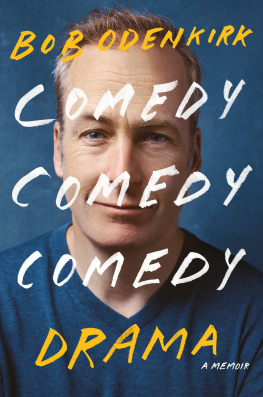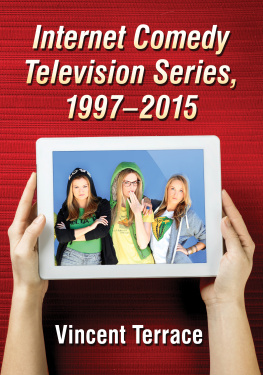Screen Comedy and Online Audiences
Screen Comedy and Online Audiences is boldly, brilliantly diverse, offering up a multi-text exploration of how different modalities, hybrids and subgenres of screen comedy are valued (or not) by an equally diverse range of audiences. Inger-Lise Kalviknes Bore also adopts a multi-sited approach, deftly analysing responses and reviews across the likes of amazon.com, Facebook, imdb, Pinterest, reddit, Tumblr, Twitter and YouTube. Brimming with insight, this book shows how indispensable fan/audience studies can be for understanding comedys cultural politics and affective resonances.
Professor Matt Hills, University of Huddersfield
At last! A detailed, evidence-based study of the major gap in the study of media and comedy; audiences. Offering a convincing argument for the specificity of comedy as a mode of popular media, this book artfully explores audience responses to a range of humorous media on TV, in film, and online. With chapters on gender, fandom, romcom, offence and comic failure, Bores analysis pinpoints the importance of finding out what people do with comedy. As such, it impressively forges an important new direction in the study of media and humour.
Dr. Brett Mills, University of East Anglia
The question of why we laugh (or dont laugh) has intrigued scholars since antiquity. This book contributes to that debate by exploring how we evaluate screen comedy. What kinds of criteria do we use to judge films and TV shows that are meant to be funny? And what might that have to do with our social and cultural backgrounds, or with wider cultural ideas about film, TV, comedy, quality and entertainment? The book examines these questions through a study of audience responses posted to online facilities such as Twitter, Facebook, review sites, blogs and message boards. Bores analysis of these responses considers a broad range of issues, including how audiences perceive the idea of national comedy; what they think of female comedians; how they evaluate romcoms, sitcoms and web comedy; what they think is acceptable to joke about; what comedy fans get excited about; how fans interact with comedians; and what comedy viewers really despise. The book demonstrates some of the ways in which we can adapt theories of humour and comedy to examine the practices of contemporary screen audiences, while offering new insights into how they negotiate the opportunities and constrictions of different online facilities to share their views and experiences.
Inger-Lise Kalviknes Bore is Senior Lecturer in the Birmingham Centre for Media and Cultural Research at Birmingham City University, UK.
Routledge Research in Cultural and Media Studies
For a full list of titles in this series, please visit www.routledge.com.
99 Historicising Transmedia Storytelling
Early Twentieth-Century Transmedia Story Worlds
Matthew Freeman
100 LGBTQs, Media and Culture in Europe
Edited by Alexander Dhoest, Lukasz Szulc and Bart Eeckhout
101 Matrix Activism
Global Practices of Resistance
Michela Ardizzoni
102 Materializing Memory in Art and Popular Culture
Edited by Lszl Munten, Liedeke Plate, and Anneke Smelik
103 The Trauma Graphic Novel
Andrs Romero-Jdar
104 Politics, Media and Democracy in Australia
Public and Producer Perceptions of the Political Public Sphere
Brian McNair, Terry Flew, Stephen Harrington, and Adam Swift
105 Spectral Spaces and Hauntings
Edited by Christina Lee
106 Affective Sexual Pedagogies in Film and Television
Kyra Clarke
107 Tracing the Borders of Spanish Horror Cinema and Television
Edited by Jorge Mar
108 Screen Comedy and Online Audiences
Inger-Lise Kalviknes Bore
First published 2017
by Routledge
711 Third Avenue, New York, NY 10017
and by Routledge
2 Park Square, Milton Park, Abingdon, Oxon OX14 4RN
Routledge is an imprint of the Taylor & Francis Group, an informa business
2017 Taylor & Francis
The right of Inger-Lise Kalviknes Bore to be identified as author of this work has been asserted by her in accordance with sections 77 and 78 of the Copyright, Designs and Patents Act 1988.
All rights reserved. No part of this book may be reprinted or reproduced or utilised in any form or by any electronic, mechanical, or other means, now known or hereafter invented, including photocopying and recording, or in any information storage or retrieval system, without permission in writing from the publishers.
Trademark notice: Product or corporate names may be trademarks or registered trademarks, and are used only for identification and explanation without intent to infringe.
Library of Congress Cataloging-in-Publication Data
Names: Bore, Inger-Lise Kalviknes, author.
Title: Screen comedy and online audiences / by Inger-Lise Kalviknes Bore.
Description: New York: Routledge, 2017. |
Series: Routledge research in cultural and media studies |
Includes bibliographical references and index.
Identifiers: LCCN 2016059205
Subjects: LCSH: Comedy filmsHistory and criticism. | Television comediesHistory and criticism. | Motion picture audiencesSocial aspects. | Television viewersSocial aspects. |
Online social networksSocial aspects.
Classification: LCC PN1995.9.C55 B67 2017 | DDC 791.43/617dc23
LC record available at https://lccn.loc.gov/2016059205
ISBN: 978-1-138-78066-8 (hbk)
ISBN: 978-1-315-77057-4 (ebk)
Typeset in Sabon
by codeMantra
I would like to thank the Birmingham Centre for Media and Cultural Research for supporting my development of this project. In particular, I appreciate the advice and help I got from Simon Coach Barber, Hazel Collie, Gemma Commane, Rajinder Dudrah, Anne Grfer, Sue Heseltine, Jon Hickman, Paul Long, John Mercer and Nick Webber. Shout out to my School of Media roomies, who provide a steady supply of laughs and coffee. Outside of Birmingham City University, I would like to thank my extended academic network. Matt Hills offered great advice, as always, and many others kindly shared their work with me. I am grateful for my family and friends, who have offered cheerleading and healthy distractions in equal measure. Finally, thank you to the Internet users who generously agreed to let me include their words in this book and to my editors, Felisa Salvago-Keyes and Christina Kowalski, for their patience and guidance.
This book is dedicated to Marc, Axel and Kasper (despite its sad lack of choo choo trains).
Our attempts at understanding humour can be traced back as far as Plato, but we still dont know exactly what it is that makes something seem funny, rather than just strange or foolish. I think this sense of mystery is what attracts me to this field. I am fascinated by the different permutations of comedy across cinema, TV and other screens, by our different tastes in comedy and by the ability of comedy to delight, disgust and fall flat. As Billig (2005) notes, Any attempt to find the objectively laughable the holy grail of comedy that will guarantee to unleash the biological mechanism of laughter will be doomed to failure (186). I am also intrigued by how audiences talk about comedy, how they express their feelings of amusement, affection, excitement or disappointment, and how they argue about whats funny and what isnt. Finally, I am interested in what we can learn by exploring how ideas of humour and comedy circulate in and across different cultures. The cultures I am focusing on in this book are online cultures, digital worlds situated on social media like message boards, review sites, blogs and social networks. Through such media, audience members around the world can participate in the ongoing debate about what it is that makes us laugh.











